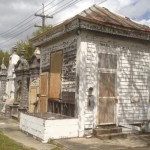
In March 2012, officials from local preservation groups in the city of New Orleans visited three cemeteries (Holt, Lafayette No. 1, and Lafayette No. 2) to assess the work being planned by the city. The preservation groups discovered the proposed $2.6M of renovations included the demolition of the historic sexton cottages at all three cemetery locations.
Since federal funds were arranged to be used for the costs of replacing the cottages, a required Section 106 procedure was launched by FEMA. The review process began with the goal to “avoid, minimize, or mitigate” unfavorable changes to the historic cemeteries. Luckily, representatives found the cottage at Holt Cemetery was in stable enough condition to be renovated. Unfortunately, the other two cottages had been neglected by the city for too long, and were considered to be in a state of disrepair. As a result, the city believed it better to demolish the buildings and turn them into maintenance sheds. The residents of the city were opposed to the alterations and fought for more than two years to try and preserve both the cemeteries and the cottages.
Common Ground: All Systems Go
After six months of debate, the city finally agreed to let preservationists submit architectural designs for the cottages' rehabilitation, so long as the cost of the plans fell within the available budget. All parties seemed happy, as the agreement was seen as the ultimate solution and a great example of a Section 106 process. Over the next year and a half, the city and preservation groups worked in unison towards a common goal. The non-profits involved met the city’s demands by having architect Michael Rouchell provide the drafting and project manual, and John Schackai of Sustainable Architects was the designer and architect of record. The designs were approved by all parties, including the government and federal agencies. The last part of the process was for the city to accept the donation of the architectural designs and services, which meant the Sustainable Architects would need to sign a Cooperative Endeavor Agreement (CEA) with the city.
The Annulment
Unfortunately, rehab of the cottages reached a standstill after the negotiations fell through over specific conditions required by the city to be part of the CEA. Using this excuse, the preservation groups learned the city no longer felt the approved designs for the Sexton Cottages were acceptable. Ultimately, the city cancelled their agreement and decided to continue with their original idea of building maintenance sheds instead of saving the historic cottages.
The preservationists weren’t done fighting yet, as they proposed alternative ways to prevent the cottage demo plans by revising the architectural designs so that even less money would be spent than the original plans the city had previously agreed to. Shockingly, the city decided to withdraw its request to use the available FEMA funds, in turn ending the Section 106 review which the preservationists relied on.
Creating an Alternative Solution
For more than two years the community’s efforts to save these two historic landmarks failed, but not for a lack of trying. One has to wonder if the community was able to use crowdfunding as an option, if FEMA funds would have been unnecessary to reach their funding needs. The residents of the city of New Orleans made their intentions clear, and if the preservationists were able to raise funds through current crowdfunding methods, it’s very likely they would have had enough support to save the cottages. How do you feel about the destruction of the historic cottages? Can you envision the use of crowdfunding as a means of restoring the historic fabric of society? Let us know what you think.



